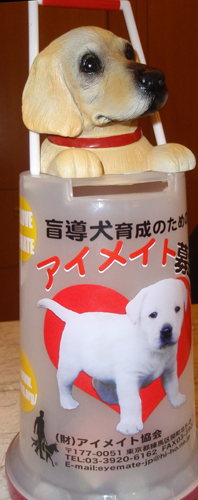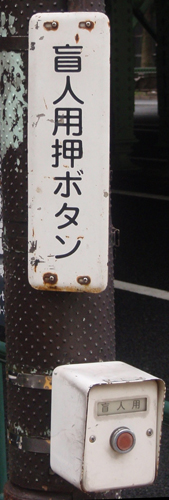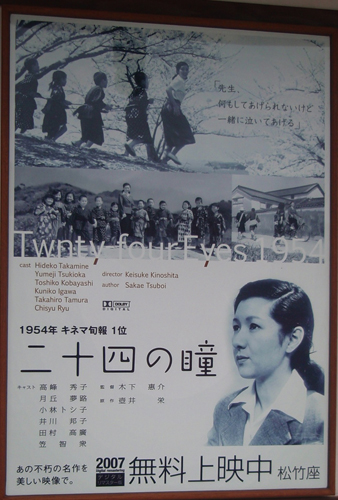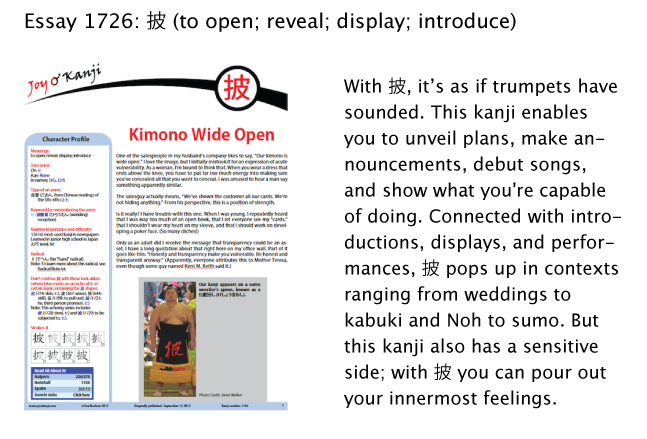The Eyes Have It
I recently befriended a blind photographer in Japan. He isn't just partially blind. Because of a heart condition and glaucoma, he had his eyeballs removed and protheses inserted. (He has posted pictures on Flickr of himself without eyeballs.)
I initially contacted him regarding essay 1571 on 壇 (platform; podium; altar; circles) because I wanted to use the following photo, to which he kindly agreed:

Photo Credit: Hirosan
It's one thing to point a camera at a waterfall that you can hear, but he photographed an ad that contained a visual pun. (The word "modern" incorporates the yomi ダン.) How did he know to do this? I'm at a loss!
At any rate, I couldn't wait to tell my language partner, Kensuke-san, about my new friend (with whom I have since had several exchanges via email and on Facebook). I didn't want there to be any confusion about whether Ryo-san could see to some degree, so I said this to Kensuke-san up front:
目玉がない人です。
He's a person with no eyeballs.
目玉 (めだま: eyeball); 人 (ひと: person)
I figured this was probably way too crude an expression for Japanese sensibilities, but at least it would be perfectly clear.
Kensuke-san murmured the following:
かわいそうです。
Poor guy.
I reassured him with this:
ポジティブ態度があります。
He has a positive attitude.
態度 (たいど: attitude)
Kensuke-san said that was a good thing.
I had no idea that we were having a "Who's on first?" conversation. As I later realized, he had misunderstood me from the start.
Although 目玉 literally means "eyeball," it figuratively means "center, focus," as in this sentence:
今日のイベントには目玉がない。
Today's event has no special feature.
今日 (きょう: today)
Kensuke-san thought I was saying that Ryo-san had nothing special about him and was boring. When he said かわいそうです, he was offering his sympathies to a dull guy. So much for being incredibly clear to the point of being too blunt!

Photo Credit: Eve Kushner
A collection box at a hotel asks people to give money to an association called アイメイト (Eyemate). Here are the largest kanji:
盲導犬 (もうどうけん: seeing-eye dog)
育成 (いくせい: training)
Quiz Spoiler About 目
As long as we're discussing eyes, I want to give away a Verbal Logic Quiz answer from essay 1968 on 岡 (hill; higher place; outside; beside). Well, of course, I don't want to spoil it for anyone. But it ties in so well that I can't help myself. If you hope to do this quiz at some point, just ... close your eyes now!
Normally, 岡 means "hill." What do you think it means here?
岡目 (おかめ: onlooker; bystander) ____ + eye
a. This 岡 means “hill.” Onlookers often stand on a hill for a better view.
b. This 岡 means “third party.” The term derives from a saying that spectators have a better perspective than players.
c. This 岡 means “land relative to the sea.” The term derives from a saying that those who remain on the beach for fear of getting wet cannot fully experience life.

Photo Credit: Eve Kushner
Here are the kanji in this sign:
盲人 (もうじん: blind person)
-用 (-よう: for the use of)
押ボタン (おしボタン: push button)
Wait, how are blind people supposed to see this sign?
b. This 岡 means “third party.” The term 岡目 (おかめ: onlooker; bystander, 3rd party + eyes) derives from a saying that spectators have a better perspective than players.
The word 岡目 comes from this yojijukugo:
岡目八目 (おかめはちもく: (1) bystander’s vantage point; outsider’s better grasp of the situation; (2) spectators at a game see more of it than players do)
3rd party + eyes + 8 + moves
In turn, 岡目八目 originated from the saying that, in the chesslike game of go, spectators can see eight moves ahead. The saying has expanded to mean that, in everything, an outsider can see what’s going on better than participants can. But the literal meaning “spectators at a game see more of it than players do” still exists and applies to actual games (though not necessarily of go).

Photo Credit: Eve Kushner
You may know that I'm really taken with the movie Twenty-Four Eyes. Its Japanese title doesn't include 目; it actually translates as Twenty-Four Pupils, as in ocular pupils, not students, even though it's about a school. Here are the kanji in the title:
二十四 (にじゅうし: twenty-four)
瞳 (ひとみ: pupil)
Two Types of 目s
As long as we're talking about 目, I'll ruin another essay for you. This sentence comes from essay 1777 on 塀 (へイ: fence; boundary wall; wall):
塀には、区画と目隠しの2つの目的がある。
A 塀 has two purposes—to mark a boundary and to provide privacy.
区画 (くかく: boundary); 目隠し (めかくし: screen); 目的 (もくてき: purpose)
Note that 目 appears here twice, first with the kun-yomi of め and then with the on-yomi of モク. On top of that, the meaning changes considerably each time. Here's how the two 目 words break down:
目隠し (めかくし: screen) eye + to conceal
目的 (もくてき: purpose) aim, objective + target
With 目隠し, it's not that the eyes are being concealed, of course. Rather, a fence hides things from the curious eyes of passers-by (much to my chagrin!).
Two Articles of Interest and a New Essay
You might be amused by a blog post about garbled kanji on British clothing. Note the update at the end; it's possible that these shirts don't actually exist. Still, the post offers a fun look at kanji.
As long as we're talking about enjoyable kanji study, I want to mention a recent Japan Times tribute to Mary Sisk Noguchi, who left us nearly nine months ago. Through her "Kanji Clinic" columns in the Japan Times, she reached thousands of people and made many fall in love with kanji. I wrote my own tribute to her back in January as I am forever in her debt.
Finally, I'd like to offer a preview of an essay I haven't yet spoiled for you! Here's the newly posted essay 1726 on 披:

Joy o' Kanji will be on a short break. I'll see you back here in two weeks!

Comments